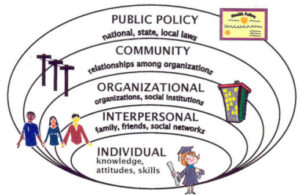The World we live in consists of different subsystems. Each individual has certain genetic predispositions, lives in a specific family and grows up in a unique local environment with all its specifics. He attends school with a specific subculture, becomes friend with certain people and with them develops specific activities. His behaviour and attitude towards cyberbullying can be influenced by all of those predispositions. Some have more effect and others less, some can have a bad, others a good influence and the amount and connotation can differ from a person to person. It is not enough to change individual attitude and behaviour (we can do that with education,…). For an efficient change, we need to address everything around him, all categories and subsystems.

Source: http://www.balancedweightmanagement.com/Socio-Ecological%20Model.jpg
Socio-ecological model recognises various levels of addressing social problems: individual, interpersonal, organisational, community, and public policy.
Approaches on different levels require specific unique unalike strategies. As with all others issue it is usually easier to tackle them on lower levels (individual, interpersonal) and most cyberbullying prevention project is presenting educational workshops and raising youth awareness as their main outcome. Addressing the higher levels can require more sources, more time and a higher level of professionalisation.
A set of actions presented in this manual is primarily focusing on the organisational level.
Addressing these levels automatical includes tackling all the lower levels as well, individual and interpersonal.
We chose organisational level because it:
- feels the most natural for prevention of cyberbullying in the school environment (don’t forget schools are organisations as well),
- exceeds and upgrades outreach of most other projects about preventing cyberbullying,
- allow us to show strong points of project partners (school access, the ability to address various target groups,…).
The project has certain effects also on the community level (cooperation project partners and schools in the coalition, creating a joint knowledge) and on a public policy level (action proposals).
The project has certain effects also on the community level (cooperation project partners and schools in a coalition, creating a joint knowledge) and on a public policy level (action proposals).